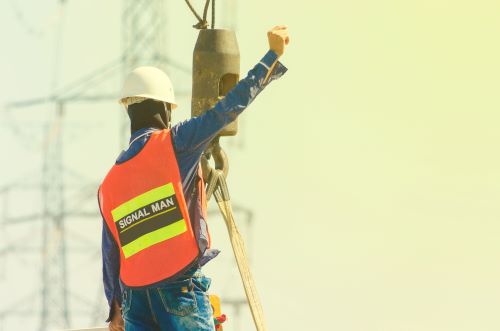
What Does a Crane Signal Person Do?

If you’ve ever spent much time on a jobsite with cranes, you’ve probably seen that crane work is never just a one-man job. The reason for this is not hard to imagine: think about how difficult it can be to park an oversize car or truck when you can’t fully see the front or back of the vehicle. Being unable to see the ground or obstructions due to vehicle size has been something that modern automotive design has taken great pains to correct with things like proximity sensors and legally mandated rear-view cameras. But those simply won’t work with something the size of a crane, which means the job typically falls to a crane signal person.
What’s the Job?
In layman’s terms, the crane signal person is the equivalent of your friend who gets out of the car to tell you just how much you can move when you’re trying to parallel park—someone with a different vantage point who can offer outside guidance. A crane signal person is the crane operator’s eyes on the ground, someone who can tell them if the load is off-balance and needs readjusting before the machinery is activated, someone who can guide them to a proper deposit, and someone who they can trust to give them directions.
In earlier jobsites, signaling was often rather arbitrary, with lift directors, crane signal persons, and crane operators meeting in advance of the lift and agreeing upon signals on the spot. However, this meant that signals could vary from jobsite to jobsite—or even from signal person to signal person—and this could be confusing, or worse, unsafe.
Fortunately, on the modern jobsite, while it is customary for the same trio—crane operators, signal persons, and lift directors—to still meet before any new lift starts, there is an agreed-upon language of crane signals set by regulatory boards like OSHA. The meeting is typically, then, to discuss any unique signals or commands that might not be OSHA standard but relevant to a certain jobsite.
When Is a Crane Signal Person Needed?
According to OSHA 1926, a signal person must be on a jobsite if:
- The point of operation (load or area near placement) is not in clear view of the operator.
- When the equipment is being moved, the view in its direction of travel is obstructed.
- Either the operator or load handler determines it is necessary.
Hand signals are the preferred method of communication for a crane signal person and crane operator because, often, workers on a jobsite might not share similar languages, and jobsites are noisy places, so verbal signals may be misunderstood amid the noise of a crane operation. Understandably, only one person should be giving signals at a time.
If you’re interested in becoming a trained crane signal person, you will find your presence welcomed at just about any jobsite. For that reason, it’s important that you get professional training and certification in all of OSHA’s standard signaling practices. If you want to start an exciting new career as a crane signal person, contact West Coast Training today.
